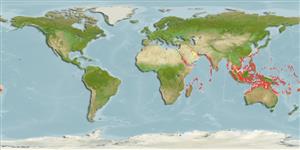Common names from other countries
>
Scombriformes (Mackerels) >
Scombridae (Mackerels, tunas, bonitos) > Scombrinae
Etymology: Grammatorcynus: Greek, gramma = signal, mark + Greek, rhyngchos = snout.
More on author: Rüppell.
Environment: milieu / climate zone / depth range / distribution range
Ecologie
marien rifbewoner; oceanodroom (Ref. 51243); diepte 15 - 50 m (Ref. 86942). Subtropical; 31°N - 25°S, 32°E - 175°W (Ref. 168)
Indian Ocean: Red Sea eastward to the Andaman Sea. Western Pacific: Ryukyu Islands to the northern coasts of Australia, including the Marshall Islands and Fiji. Often confused in the literature with Grammatorcynus bicarinatus.
Lengte bij maturiteit / Grootte / Gewicht / Leeftijd
Maturity: Lm 41.5, range 40 - 43 cm
Max length : 100.0 cm FL mannelijk / geslacht onbekend; (Ref. 9684); common length : 50.0 cm TL mannelijk / geslacht onbekend; (Ref. 5450); max. gepubliceerd gewicht: 3.5 kg (Ref. 168)
Dorsale stekels (totaal): 11 - 13; Dorsale zachte stralen (totaal): 10-14; Anale stekels 0; Anale zachte stralen: 10 - 14. Mouth relatively small, upper jaw reaching about to middle of eye. Pectoral fins stout. Interpelvic process short and single. No prominent anterior corselet present. Swim bladder present. Vertebrae 14 precaudal plus 17 caudal, total 31 as in mackerel (Scomber and Rastrelliger).
Inhabits open water but often seen swimming near outer reef walls or deep clear-water slopes (Ref. 48637). Found mostly in shallow reef waters where it forms large schools. Feeds on crustaceans and fishes, particularly clupeoids (Sardinella, Thrissocles), and other fishes such as Sphyraena and Balistes. Marketed canned and frozen (Ref. 9684). Its flesh is mild and pleasantly flavored, but brushed with lemon juice prior to cooking to remove the ammonia-like smell (Ref. 9684).
Collette, B.B. and C.E. Nauen, 1983. FAO Species Catalogue. Vol. 2. Scombrids of the world. An annotated and illustrated catalogue of tunas, mackerels, bonitos and related species known to date. Rome: FAO. FAO Fish. Synop. 125(2):137 p. (Ref. 168)
Status op de Rode Lijst van het IUCN (Ref. 130435)
CITES (Ref. 128078)
Not Evaluated
Gevaar voor de mens
Harmless
Gebruik door de mens
Visserij: van minder commercieel belang; sportvis: ja
Meer informatie
ReferentiesAquacultuurAquacultuurprofielKweeklijnenGeneticaElectrophoresesErfelijkheidZiektesVerwerkingMassaconversie
Tools
Speciale rapporten
Download XML
Internetbronnen
Estimates based on models
Preferred temperature (Ref.
115969): 25.6 - 29.1, mean 28.2 (based on 632 cells).
Fylogenetische diversiteitsindex (Ref.
82804): PD
50 = 0.7500 [Uniqueness, from 0.5 = low to 2.0 = high].
Bayesian length-weight: a=0.00955 (0.00464 - 0.01966), b=3.05 (2.88 - 3.22), in cm Total Length, based on LWR estimates for this (Sub)family-body shape (Ref.
93245).
Trofisch niveau (Ref.
69278): 4.2 ±0.69 se; based on food items.
Weerstandsvermogen (Ref.
120179): Gemiddeld, minimale populatieverdubbelingstijd 1,4-4,4 jaar (Preliminary K or Fecundity.).
Fishing Vulnerability (Ref.
59153): High to very high vulnerability (67 of 100).
Climate Vulnerability (Ref.
125649): Very high vulnerability (89 of 100).
